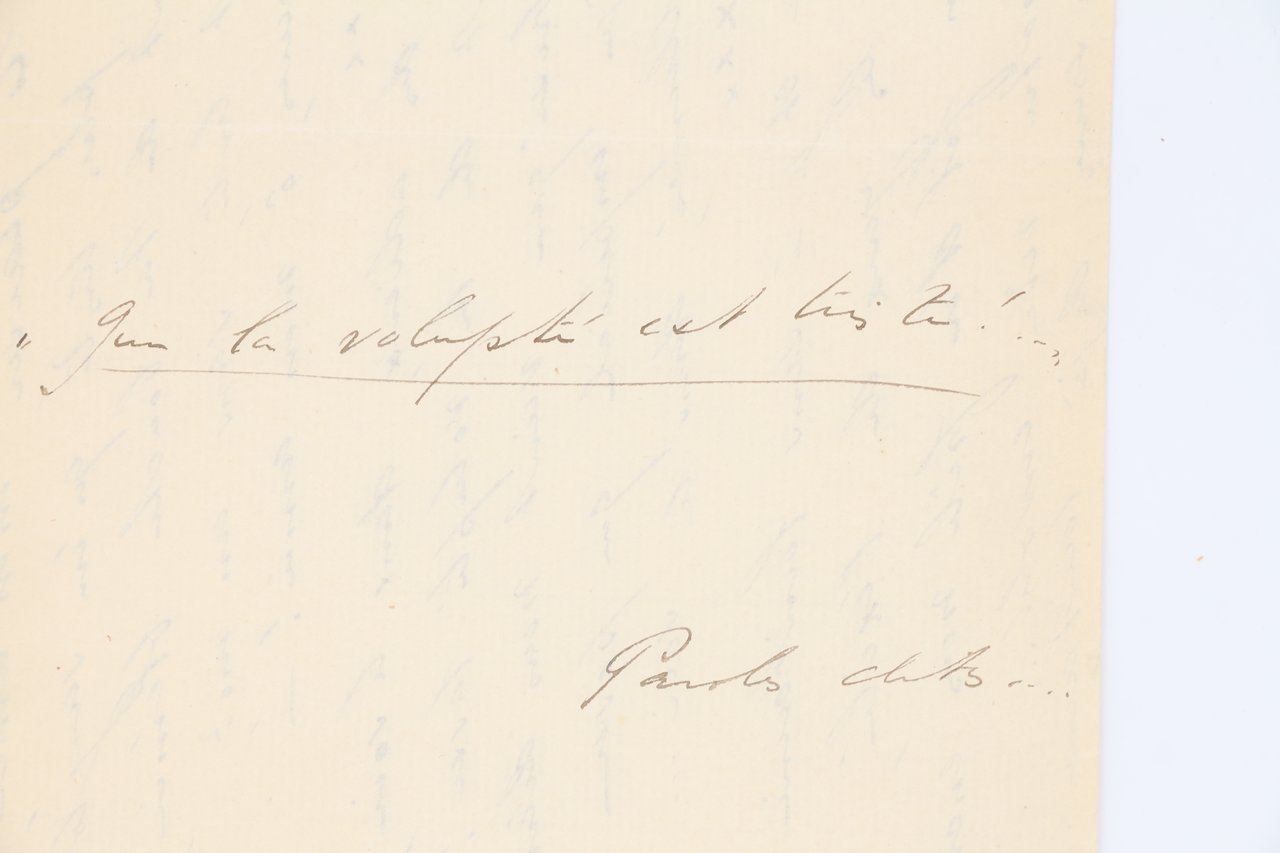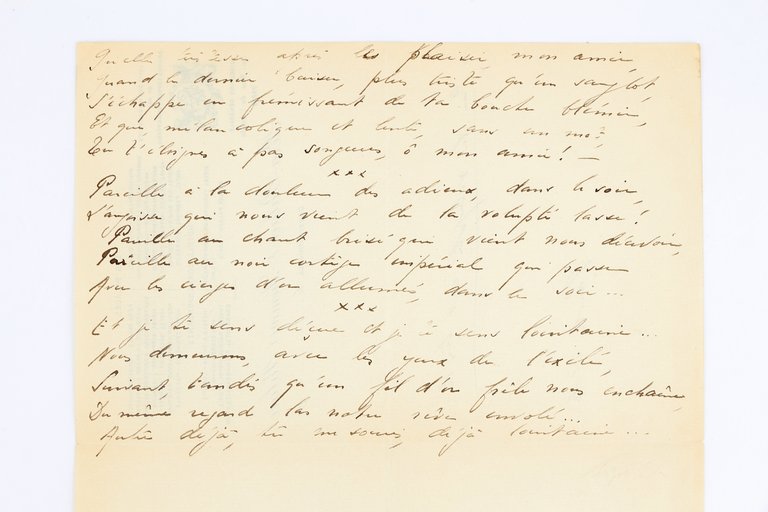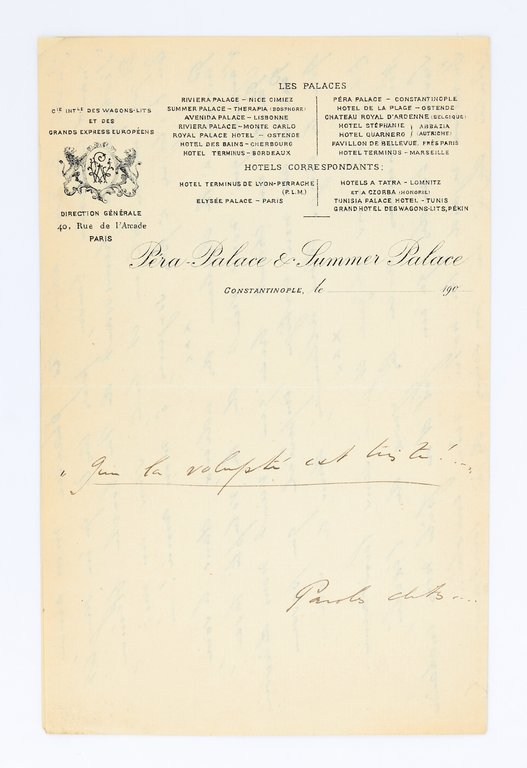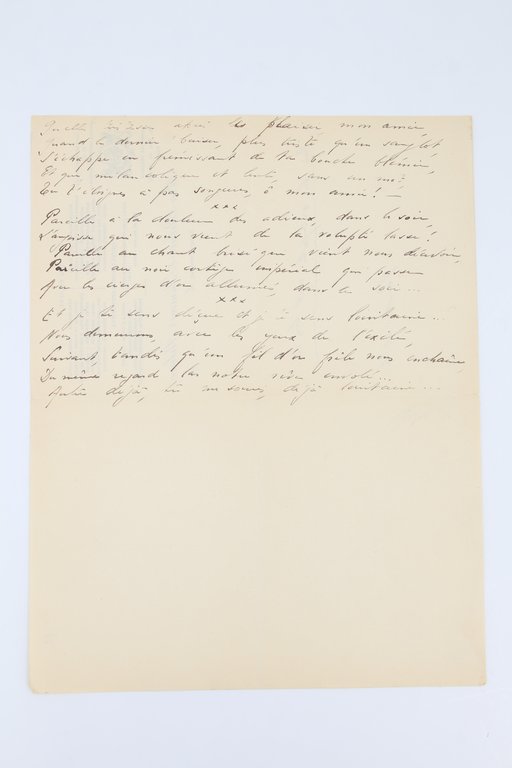- Constantinople s.d. (1907), 21x27cm, 1/2 page et quelques lignes sur un feuillet. - Handwritten poem to Kérimé « Que la volupté est triste.!» [Paroles soupirées] Constantinople [1907] | 21 x 27 cm, 1/2 page and a few lines on a leaf Handwritten poem entitled « Que la volupté est triste. ! », dedicated and offered to Kérimé. Half a page written in black ink on a leaf of headed paper from the Constantinople Péra-Palace & Summer-Palace, a total of 15 alexandrine verses. The poem was published under the title «Paroles soupirées» in Flambeaux éteints (Edward Sansot & Cie, 1907). This first manuscript version has several variations from the printed text. Some verses have even been totally abandoned: "Pareille au chant brisé qui vient nous décevoir,/ Avec les cierges d'or allumés dans le soir". Quelle tristesse après le plaisir, mon amie, Quand le dernier baiser, plus triste qu'un sanglot, S'échappe en frémissant de ta bouche blêmie, Et que, mélancolique et lente, sans un mot, Tu t'éloignes à pas songeurs, ô mon amie! Pareille à la douleur des adieux, dans le soir, L'angoisse qui vient de la volupté lasse! Pareille au chant brisé qui vient nous décevoir, Pareille au noir cortège impérial qui passe Avec les cierges d'or allumés dans le soir. Et je te sens déçue et je me sens lointaine. Nous demeurons, avec les yeux de l'exilé, Suivant, tandis qu'un fil d'or frêle nous enchaîne, Du même regard las notre rêve envolé. Autre déjà, tu me souris, déjà lointaine. Provenance: Kérimé Turkhan-Pacha. The Sappho lover and her sofa muse Considered as a literary work in its own right, Renée Vivien's correspondence with Kérimé Turkhan-Pacha is sprinkled with very rare poems that enhance the poet's romantic passion for her oriental muse. In spring 1904, Vivien received an unexpected letter. A mysterious young Turkish woman, living in Constantinople and who signed Kérimé Turkhan-Pacha, enthusiastically told her about a book she had just read. [.] Intrigued and at the same time flattered, Vivien responded to the unknown woman [.] This letter was to be followed by more than a hundred others and dozens of postcards to Kérimé Turkhan-Pacha. [.] During the summer of 1905, when Vivien will make a pilgrimage to Lesbos with Natalie Barney, she will absolutely stop in Constantinople to get to know the fictional (as she imaged) Kérimé. She saw her again several times, always in Constantinople, and their correspondence continued until 1908. Born in 1876, Kérimé Turkhan-Pacha belonged to the Constantinople high society. Very cultured, raised French, she shone in the salons of the Ottoman capital. She was distinguished by her real beauty [.]. This seductive creature, whom Vivien had to imagine languishing on cushions in the shade of a Bosphorus harem, had married a Turk much older than her around 1900, Turkhan-Pacha. [.] Becoming a widow, Kérimé lived in Paris, where she had the opportunity to court Natalie Barney; she died in Athens in 1948. Worldly and very beautiful, [.] Kérimé belonged to the Turkish elite [.] whose women began to change their mentality. Just like Loti's Désenchantées [.] Kérimé found it troublesome to support the old customs of her country. «I was very young and I was cloistered away and aspired only to bite all the forbidden fruits», she told Le Dantec. [.] For Vivien, Kérimé represented the mirage of the East, which had already fascinated the entire 19th century: Chateaubriand, Delacroix, Nerval, Flaubert, Loti, Barrès. Turkish romanticism then permeated French literature. In 1898 Jean Lorrain had published La Dame turque (another pasha woman.) and in 1906 Loti would publish his famous novel Les Désenchantées." (J.-P. Goujon, Tes blessures sont plus douces que leurs caresses) This superb elegy with its "Bosphorus sultana" takes up all the elements of this aesthetic mythology in a superb sapphic reappropriation of the languor and sensuality of the fantasized East. Exceptionally rare, the manuscript




Découvrez comment utiliser
Découvrez comment utiliser

